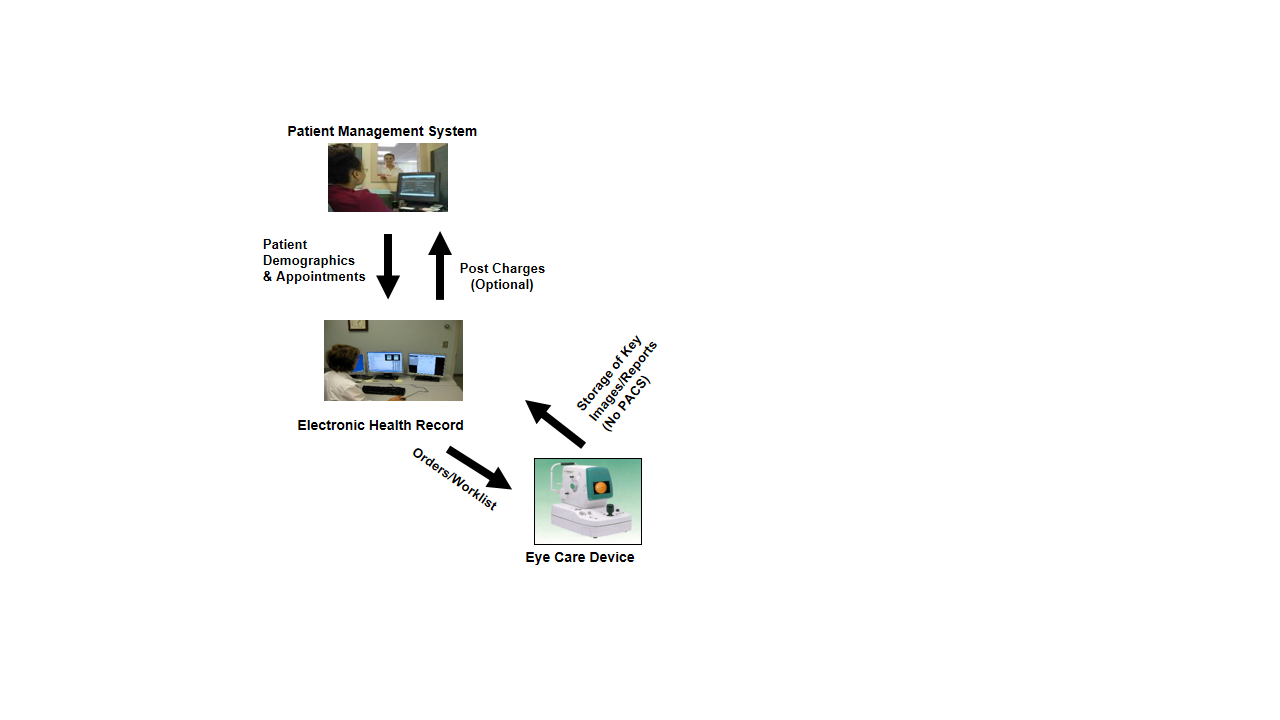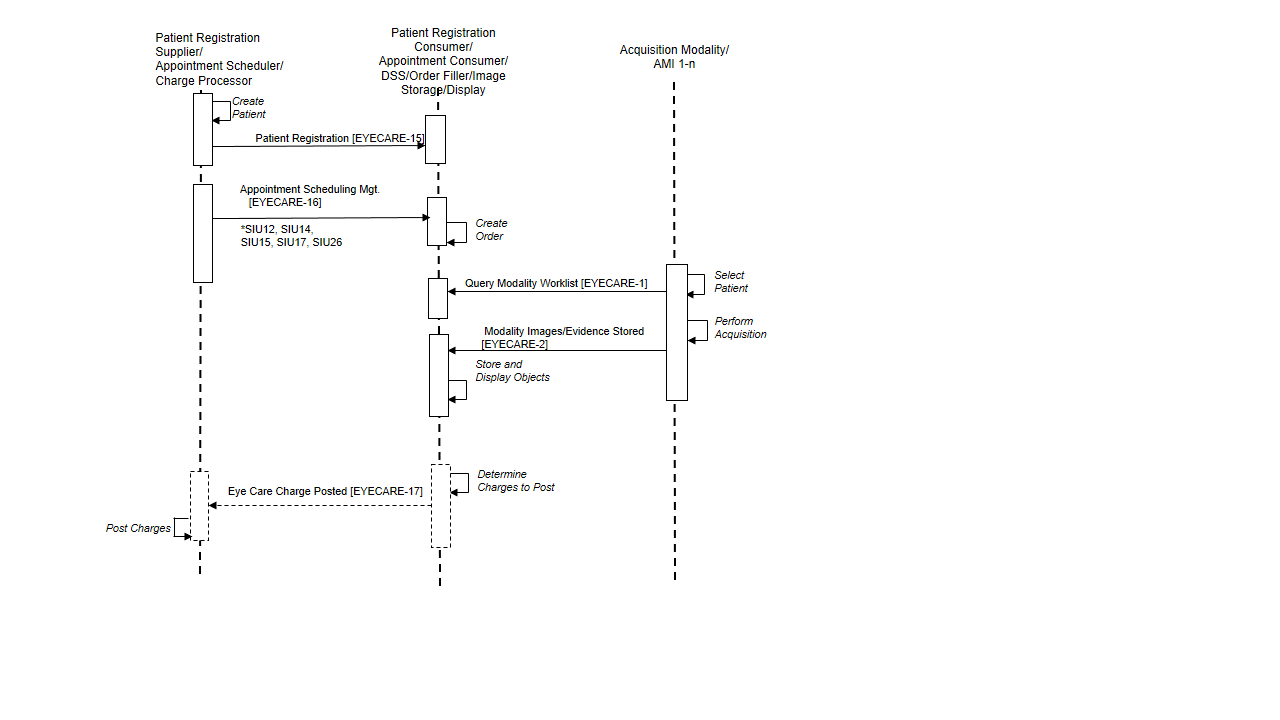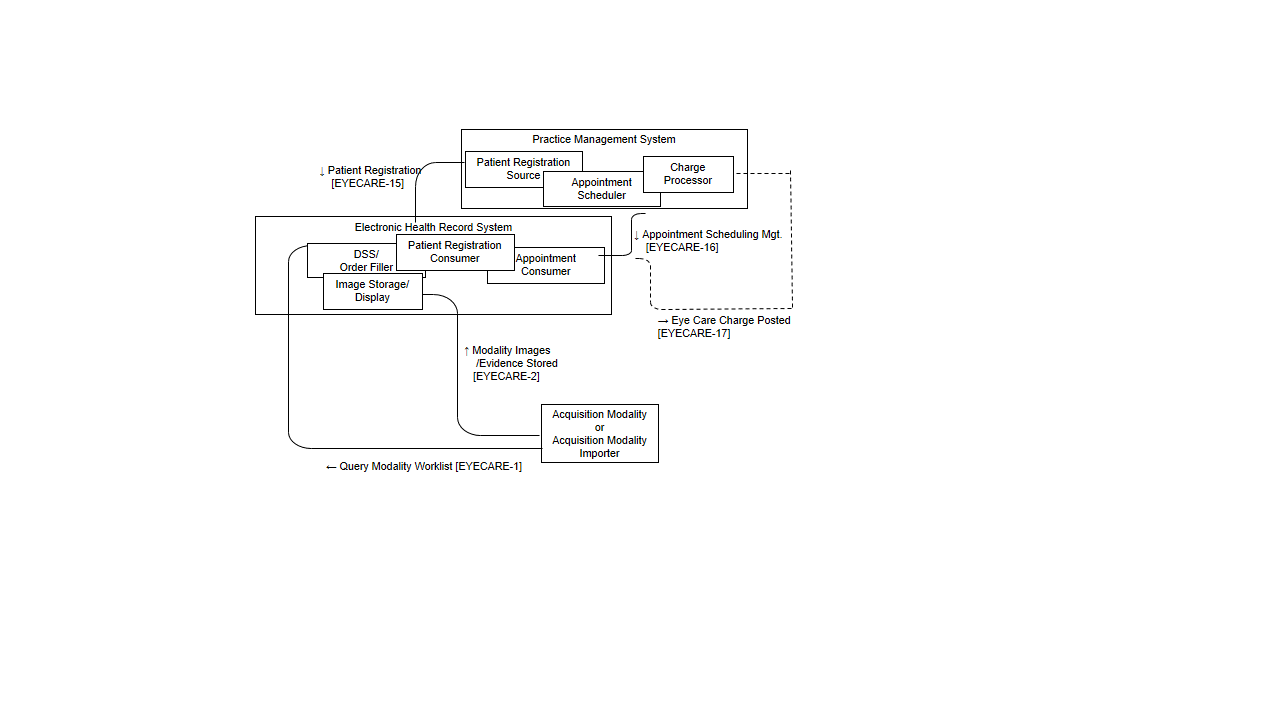Core Eye Care Workflow
Summary
Core Eye Care Workflow (C-EYECARE) profile addresses a scenario where organizations have a Practice Management System (PMS), Electronic Health Record System (EHR) and eye care diagnostic imaging and testing equipment (fundus cameras, slit lamps, refractive measurement devices, visual fields etc.).
It enables the consistent handling of patient identifiers and demographic data among the above types of systems. It includes support for features such as patient registration, appointment scheduling, eye care orders and equipment modality worklist. It reduces the implementation requirements of the other eye care workflows by not integrating an Image Archive (i.e. PACS system). Therefore, users of this profile must understand that acquisition devices and users are responsible for the safe keeping of the images and/or measurements created upon their system. It is important for users to understand how this is accomplished so that patient data is protected. How this is accomplished is outside the scope of IHE.
Details
C-EYECARE focuses on HL7 V2 messages that are commonly used in an eye care clinic, such as HL7 SIU (appointment scheduling) messages and HL7 ADT (out-patient registration). These HL7 messages are used to coordinate patient and appointment scheduling information between systems such as a PMS and EHR. The appointment scheduling messages are not included in A-EYECARE or B-EYECARE and provide additional features.
C-EYECARE specifies basic requirements for DICOM integration such as DICOM Modality Worklist and DICOM Storage. The DICOM features are a subset of the features defined in the Basic and Advanced Eye Care Workflow Integration Profiles.
C-EYECARE supports an optional feature to perform billing services between a Charge Processer (often part of a PMS system) and a Department Scheduling System/Order Filler (often part of an EHR system). It utilizes a transaction based upon a HL7 DFT (Detailed Financial Transaction) message.
All HL7 messages in C-EYECARE are based upon HL7 v2.5.1
Typical Workflow Example
Patients are registered and patient demographics are distributed using the HL7 ADT_A04 message. The patient’s appointment is created/managed (i.e., PMS) and sent to consuming systems (i.e., EHR7) via HL SIU messages. This includes new appointments, updates such as confirmed, arrived, checked in, complete. It also supports cancel/delete appointments and patient no shows.
The DSS/OF (i.e., EHR) creates patient orders internal to its system.
DICOM Modality Worklist (MWL) is used to convey patient and demographic information to eye care acquisition devices. The query may be broad (get a list of scheduled procedures from which one will be selected), or patient-specific (provided with sufficient query keys to get back the scheduled procedure for a single patient). Eye Care procedures may be performed on multiple Acquisition Modalities or Acquisition Modality Importers, therefore, multiple devices may perform the queries.
The patient is selected and the eye care device performs the acquisition. Each Modality (eye care device) may produce a variety of images and other evidence (visual fields, refractive and biometry information, etc.). The key DICOM SOP instances are stored to the Image Storage/Display which resides on the EHR. The Image Storage/Display is highly recommended to support all the object types as specified by the Eye Care Image Option, the Eye Care Measurement Option and the Encapsulated PDF Option.
The Image Storage/Display Actor stores the DICOM SOP Instances and is able to display them to the user of the system.
The DSS/Order Filler provides charging information to the Charge Processor and the Charge Processor post the charges.
Systems Affected
- Practice Management System or Enterprise-wide information systems that manage patient registration and services ordering (i.e., admit-discharge-transfer (ADT)/registration system and hospital information system (HIS))
- Electronic Medical Record System or Departmental information systems that manage department scheduling
- Acquisition modalities (e.g., fundus cameras, ultrasound machines, ophthalmic tomography devices, slit-lamp biomicroscopes)
Actors & Transactions:
Specification
Profile Status: Trial Implmentation
Documents: Eye Care Technical Frameworks
Underlying Standards:
See Also
http://one.aao.org/CE/PracticeGuidelines/Information_Technology.aspx


